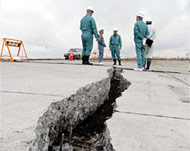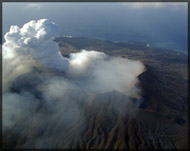Japanese volcano victims head home
Residents of an island south of Tokyo are preparing to return home after receiving official permission in spite of lingering concerns about their safety.

Vulcanologists say they cannot accurately predict whether the volcano is likely to erupt again, while the crater continues to belch clouds of poisonous sulphur dioxide.
But these hazards are not enough to put off the majority of the 3850 residents of Miyake island, who were evacuated to mainland Japan in September 2000.
It is nearly four years since most of them saw their island and they want to go home; Mayor Sukeyasu Hirano announced on 13 July that they will be allowed to return in February.
“It’s a beautiful place to live and I just want to go back to my old way of life,” said Yukiaki Shimamura. “Many of us are very sad because island life is very different from city life.
“There, we have the beautiful ocean, the trees, the mountain and there are many things to do, but the city is very expensive and it’s hard to be away from home,” he said. “All of us feel the same way.”
Test of endurance
Shimamura worked for the island’s administrative office, which has now been relocated 120 miles away to Tokyo and helps islanders find work and accommodation. Most have experienced difficulties adapting to their new way of life.
 |
|
Life on the mainland has been an |
“We know it might be a little dangerous, because of the gas and another possible eruption, but we are taking precautions and I still want to go,” he said.
“We have been away from home for much too long,” said Koichiro Sakaue. “If I had a chance, I’d go right away, although I am a little worried about what our homes and our gardens will be like after we have been away for four years.”
Sakue, 34, and his 37-year-old wife, Yuka, agree that everyone they know from Miyake has found living in mainland Japan a test of endurance and they just want to return home.
Serious problem
The island’s exiled authorities are preparing safety manuals for all the returning evacuees, an early-warning system is to be installed to warn of an imminent eruption of the 813m peak, and everyone is to be issued a gas mask that they will have to keep with them at all times.
“This poses a serious problem for vulcanologists as we cannot predict future activity at all,” said Shigeru Suto, an expert with the National Institute of Advanced Science and Technology who has studied the eruptions of Miyake’s Mount Oyama.
|
“It’s a beautiful place Yukiaki Shimamura, displaced resident of Miyake island |
“The amount of poisonous gas being emitted by the volcano is at a constant level and I can certainly understand why the people want to go back, but for some people it could prove very dangerous,” he said.
“The elderly and anyone with respiratory illnesses, such as asthma, are most at risk.”
The Tokyo Metropolitan Government is providing new houses for people who want to go back, complete with airconditioning units and filters to keep carbon dioxide out, but there are not enough houses for everybody, says Setsuya Nakada, a volcano expert with the Volcano Research Centre of Tokyo University.
Danger zone
“In some places, the concentrations of sulphur dioxide are very high, although it is generally possible to predict the path of clouds of gas as the wind in the winter generally comes from the west and in the summer it is from the south. But some people are definitely at risk,” he said.
 |
|
Minor earthquakes and volcanic |
Japan is one of the most seismologically active countries in the world, experiencing hundreds of earthquakes a year – albeit mostly minor – and several volcanic eruptions. Because of the density of the population, many communities are located close to volcanoes and eruptions occasionally claim the lives of nearby residents.
Miyake island is part of a chain called the Izu Islands that stretches hundreds of miles south from Tokyo Bay – the tips of volcanoes that protrude above the surface of the Pacific Ocean and each potentially liable to erupt.
Mayor Hirano met with Tokyo Governor Shintaro Ishihara on 13 July to ask for assistance – mostly financial – to help the residents of the island return home.
“I have considered the opinions of residents and their safety and I have concluded that it is time to return,” Hirano said later in the day.
Damage assessment
An advance team comprising the mayor and a handful of local officials arrived on the island on 27 July to set up a local headquarters and prepare for the evacuees’ return.
 |
|
Poisonous gas emitted by Mount |
“You are facing a difficult task, especially as there is only a limited number of people in the group,” the Yomiuri newspaper quoted the mayor as telling the task force. “But I hope you will work hard to ensure that people can return home safely.”
Early surveys of the island have revealed some areas that are relatively untouched by the effects of the eruptions, while other districts are still affected by clouds of poisonous gas.
The gas has devastated wooded areas and the elements have stripped them of their bark, while streams of black mud forced out of the volcano’s vents have buried cars and homes.
The popular tourist village of Miike, which had several small hotels and a beach, is off-limits to visitors because of dense pockets of gas. But in Ako, around 100 residents have paid brief visits to their properties to assess the damage and begin the clean-up operation.
Contingency plan
In an attempt to reassure those who may be wavering about returning, the island’s government has adopted the slogan “Living together with volcanic gas” and plans to monitor sulphur dioxide emissions around the clock.
“I have considered Miyake Mayor Sukeyasu Hirano |
Areas of the island with the highest concentrations of volcanic gas will be off limits, including the crater and eastern sections of the island, while an evacuation plan is being drawn up to deal with a new eruption of Mount Oyama.
Jun Ishikawa, a spokesman for the Tokyo City Government, said: “The people are very eager to go back and because the volcano is calm at the moment. They believe this is their chance.”
He added: “The mayor was elected in February and his manifesto stated that he would take everyone back this year or next. Now, he has to keep his promise.”